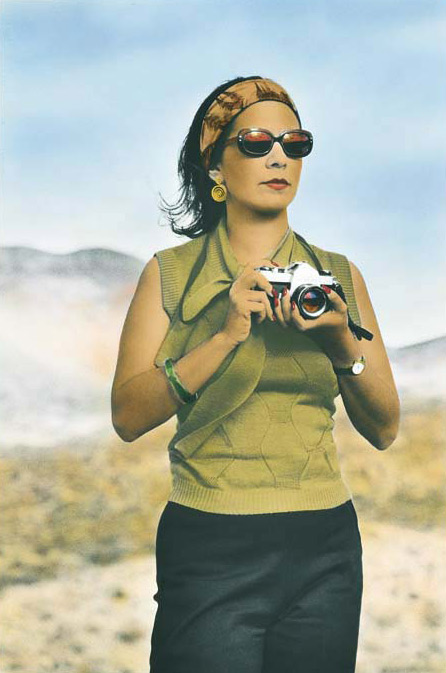In 1999, ten years after coming to critical attention in Australia, Tracey Moffatt created the one and only self-portrait in her oeuvre. In this hand-coloured photograph, of modest dimensions, Moffatt presents herself as a photographer. She defines herself in terms of her profession, revealing aspects of her technique, her previous work and her influences.
Moffatt is one of Australia's most internationally recognised photographers and film-makers. Born and raised in Brisbane, Moffatt studied art at Queensland College of Art, before moving to Sydney in the early 1980s. In 1989 her solo exhibition of the series Something More at the Australian Centre for Photography established her within the Australian art world. By 1997 Moffatt was one of the first contemporary Australian artists to have her work exhibited at New York's prestigious Dia Center for the Arts. Her work has been exhibited throughout Australasia, Europe, the United States of America and Asia. Currently, she lives and works in New York.
In her self-portrait Moffatt is positioned centrally in the composition, holding a camera in her hands. She is poised, ready to raise the camera to her eye and capture her next subject. Looking beyond our field of vision, she is contemplating the next image she will create. Photography is often described as an art of the eye, in contrast to painting, which is the art of the hand. By presenting herself at this moment of choice, Moffatt highlights this aspect of photography. Moffatt descibes her images as 'the dreams I have when I am awake'. She reveals an important aspect of her artistic technique -dreaming, choosing, composing.
Moffatt, however, reveals nothing of what her next subject will be. The only glimpse we get is the black and red reflection apparent in her sunglasses, and the camera's lens. At first glance we assume that Moffatt is in a landscape and that she is looking at a scene similar to that which we see behind her. If we correlate the colours, however, we find that there is no continuity between these two subjects. The blue, purple and orange landscape -reminiscient of the Central Australian landscapes of Albert Namatjira - contrasts starkly with the red and black reflections.
The landscape looks distinctly like a 1950s painted film set. The lack of clarity and the colours used to portray the landscape contribute to the sense that this image was taken on a set. Standing in front of this painted set, possibly in a studio with a crew around her, Moffatt poses as a photographer rather than recording an actual moment in her life. By using a set to create a staged image, Moffatt refers to works she has previously created as well as elaborating on her photographic technique. In both the series Something More (1989) and the short film Night Cries (1989) Moffatt portrays her subjects in the painted landscape of a movie-style set. Both of these works are from early in her career. Thus Moffatt reminds us of her beginnings.















